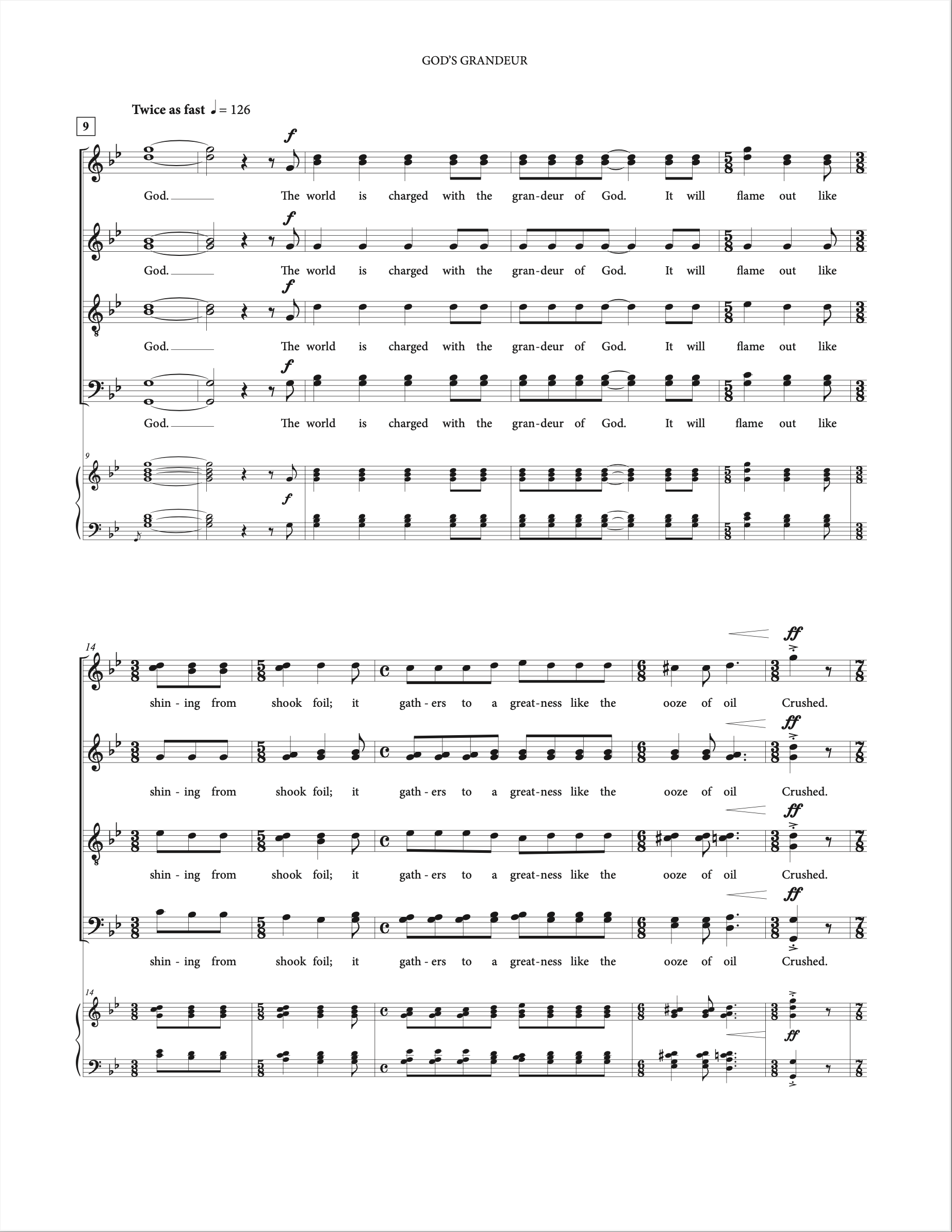 Image 1 of 7
Image 1 of 7

 Image 2 of 7
Image 2 of 7

 Image 3 of 7
Image 3 of 7

 Image 4 of 7
Image 4 of 7

 Image 5 of 7
Image 5 of 7

 Image 6 of 7
Image 6 of 7

 Image 7 of 7
Image 7 of 7








God's Grandeur
SATB Chorus a cappella (2023)
Text by Gerard Manley Hopkins (1844-1889)
God’s Grandeur, one of a number of “holy sonnets” by Irish Jesuit poet Gerard Manley Hopkins, is a stirring ode infused with a spirit of “panentheism”—the belief that the divine intersects with every part of creation, fully inhabiting it, yet also transcending it. It is also a poem about our own human insensitivity to this mysterious indwelling, and our subsequent misuse and abuse of creation. Composed during the fall of 2022/winter of 2023 for James Franklin and the East Carolina University Chamber Singers, my setting of Hopkins’ masterful text highlights the poet’s characteristic use of what he referred to as “sprung rhythm”, a poetic cadence that imitates the rhythms of natural speech. Packed with densely interlocking stress patterns and driving irregular rhythms, the opening section bristles with energy, conjuring up both the irrepressible divine/creative spirit in the world and our own equally irrepressible human/destructive spirit at work within it. The second, more lyrical, section serves as a contrast to the first, giving a sense of the divine presence in nature as something profound, immense, slow-moving, and inexhaustible. The final section brings back the irregular rhythms of the opening, but this time in a major mode and with a dancing rather than driving energy. Taken all together, God’s Grandeur offers the hope that, though darkness may seem to be all about us, a new morning for creation may yet dawn, provided we humans learn to cherish the world we have been given and learn to recognize its inherent sacredness.
SATB Chorus a cappella (2023)
Text by Gerard Manley Hopkins (1844-1889)
God’s Grandeur, one of a number of “holy sonnets” by Irish Jesuit poet Gerard Manley Hopkins, is a stirring ode infused with a spirit of “panentheism”—the belief that the divine intersects with every part of creation, fully inhabiting it, yet also transcending it. It is also a poem about our own human insensitivity to this mysterious indwelling, and our subsequent misuse and abuse of creation. Composed during the fall of 2022/winter of 2023 for James Franklin and the East Carolina University Chamber Singers, my setting of Hopkins’ masterful text highlights the poet’s characteristic use of what he referred to as “sprung rhythm”, a poetic cadence that imitates the rhythms of natural speech. Packed with densely interlocking stress patterns and driving irregular rhythms, the opening section bristles with energy, conjuring up both the irrepressible divine/creative spirit in the world and our own equally irrepressible human/destructive spirit at work within it. The second, more lyrical, section serves as a contrast to the first, giving a sense of the divine presence in nature as something profound, immense, slow-moving, and inexhaustible. The final section brings back the irregular rhythms of the opening, but this time in a major mode and with a dancing rather than driving energy. Taken all together, God’s Grandeur offers the hope that, though darkness may seem to be all about us, a new morning for creation may yet dawn, provided we humans learn to cherish the world we have been given and learn to recognize its inherent sacredness.
SATB Chorus a cappella (2023)
Text by Gerard Manley Hopkins (1844-1889)
God’s Grandeur, one of a number of “holy sonnets” by Irish Jesuit poet Gerard Manley Hopkins, is a stirring ode infused with a spirit of “panentheism”—the belief that the divine intersects with every part of creation, fully inhabiting it, yet also transcending it. It is also a poem about our own human insensitivity to this mysterious indwelling, and our subsequent misuse and abuse of creation. Composed during the fall of 2022/winter of 2023 for James Franklin and the East Carolina University Chamber Singers, my setting of Hopkins’ masterful text highlights the poet’s characteristic use of what he referred to as “sprung rhythm”, a poetic cadence that imitates the rhythms of natural speech. Packed with densely interlocking stress patterns and driving irregular rhythms, the opening section bristles with energy, conjuring up both the irrepressible divine/creative spirit in the world and our own equally irrepressible human/destructive spirit at work within it. The second, more lyrical, section serves as a contrast to the first, giving a sense of the divine presence in nature as something profound, immense, slow-moving, and inexhaustible. The final section brings back the irregular rhythms of the opening, but this time in a major mode and with a dancing rather than driving energy. Taken all together, God’s Grandeur offers the hope that, though darkness may seem to be all about us, a new morning for creation may yet dawn, provided we humans learn to cherish the world we have been given and learn to recognize its inherent sacredness.
This is a digital score sold on the honor system. Please be honest and purchase the total number of copies you intend to print and/or use. After your purchase you will be emailed a PDF within 24 hours with a personalized watermark noting copy permissions.